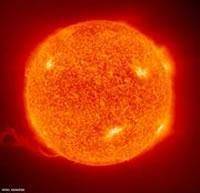
Chemistry, 01.09.2020 19:01 drippyc334
Massive stars fuse hydrogen, then helium, and finally develop carbon-oxygen cores. At about 1 billion K, they are able to ignite carbon, then oxygen, neon and magnesium fuse to make silicon, and finally iron. Because more and more protons are used up to make heavier atoms, we could expect


Answers: 1


Other questions on the subject: Chemistry


Chemistry, 21.06.2019 15:30, kristineford198
Determine the empirical formula of a compound containing 40.6 grams of carbon, 5.1 grams of hydrogen, and 54.2 grams of oxygen. in an experiment, the molar mass of the compound was determined to be 118.084 g/mol. what is the molecular formula of the compound? for both questions, show your work or explain how you determined the formulas by giving specific values used in calculations.
Answers: 3

Chemistry, 22.06.2019 03:50, daniel9299
Consider the reaction: n2(g) + o2(g) ? 2no(g) kc = 0.10 at 2000oc starting with initial concentrations of 0.040 mol/l of n2 and 0.040 mol/l of o2, calculate the equilibrium concentration of no in mol/l how would this be done?
Answers: 3
You know the right answer?
Massive stars fuse hydrogen, then helium, and finally develop carbon-oxygen cores. At about 1 billio...
Questions in other subjects:

Computers and Technology, 03.04.2020 02:48

Mathematics, 03.04.2020 02:48


Physics, 03.04.2020 02:49


Mathematics, 03.04.2020 02:49



Mathematics, 03.04.2020 02:49




